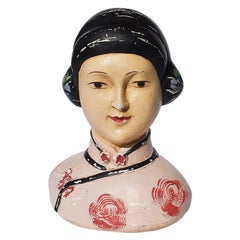Esther Hunt
Recent Sales
Mid-20th Century American Chinoiserie Busts
Ceramic, Paint
A Close Look at chinoiserie Furniture
Emerging in the 17th century, chinoiserie appropriated the aesthetics and imagery of popular East Asian design for European-made versions. Reflecting the exoticization of China, Japan and other countries in this era, the word directly translates from French to “Chinese-esque,” which reveals its shortcomings as a style of furniture and decor that often stereotypically and reductively mimics Asian culture rather than showcasing and paying tribute to its artistic traditions.
The enthusiastically decorative chinoiserie style was propelled by influential tastemakers including French King Louis XIV, whose Trianon de Porcelaine in 1670 was inspired by Chinese architecture. Expanded trade between the East and West led to a demand for porcelain, lacquer objects, silk and other goods, which further informed the fanciful furniture being crafted in Europe.
Artisans working in the chinoiserie style used materials and elements like pagoda shapes, bamboo, lacquer surfaces, bird and flower motifs and other interpretations of Asian design on pieces that were frequently set against vibrant wallcoverings. This whimsical approach yielded chinoiserie furniture that boasted dramatic flourishes drawing on the natural world and reflected the dominance of Rococo during the 18th century.
As chinoiserie was shaped by approximations of Asian design by European creators, it had regional variations, such as Chinese Chippendale in England where cabinets, chairs and tea tables had wooden fretwork designs and “japanned” surfaces intended to resemble lacquer work that was created in East Asia. In North America, furniture makers in Boston and New York integrated chinoiserie-painted scenes into Queen Anne furniture.
Antique chinoiserie furniture has continued to be fashionable, from its popularity with decorators of the Hollywood Regency era — James Mont, Tommi Parzinger, William Haines and Samuel Marx favored the style — to contemporary interior designers, although it brings with it a complex history.
Find a collection of chinoiserie bedroom furniture, cabinets, decorative objects and more on 1stDibs.
Finding the Right busts for You
The presence of vintage and antique bust sculptures can add a necessary decorative layer to any interior. And just because a statue looks classical doesn't mean it has to be conventional.
A touch of whimsy, a dose of drama — a single bust can alter a room. And when placed in just the right spot, these statues can almost feel alive.
“They give humanity in a way that a more abstract sculpture can’t give,” says Los Angeles designer Timothy Corrigan, who loves pieces that beg to be touched. For a welcoming entry hall project in California, Corrigan selected an antique Persian rug and a bust that invites you to touch it. A collection of sculptures in wood, marble and brass complement the star of the show.
For Consort cofounder and creative director Mat Sanders, a bust doesn’t have to be pretty. “I most enjoy busts that are a little busted,” Sanders jokes — but choose something with a soul you can live with, as “sculpture representative of the human form carries with it an energy you will add to the space.”
The antique and vintage bust sculptures for sale on 1stDibs include Art Deco busts, mid-century modern busts and more.
